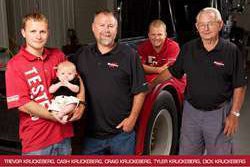There’s a very real chance in the not-too-distant-future that the way some of your customers look will change.
They will get taller, wider and a lot heavier.
E-commerce is an increasingly popular option because it allows the customer to order what they need at their convenience, but I think there’s a more convenient method on the horizon.
Eventually, trucks will place parts orders themselves.
Tractors are already capable of communicating faults to drivers and fleets, but it’s only a matter of time before the truck takes it a couple steps further.
The next great wave in truck maintenance will be in prognostics; technology that allows the truck to communicate that a failure event is imminent, but has not yet occurred.
Such technology would allow fleets and drivers to have a repair made before the truck actually breaks down and potentially slash downtime down to practically nothing. Or as close to nothing as you can reasonably get.
Once prognostic technology arrives on a wide scale and gets refined, I would fully expect the truck to place the order for the needed part without much human interaction.
That’s not to say the truck will be reaching out to you directly, but if the truck communicates back to the fleet that it is about to experience of failure of X-part number and can talk to the software that manages the fleet’s parts inventory – or communicate with the vendor’s software – that’s about a streamlined as you can get.
A service ticket could be generated in a matter of seconds, and it wouldn’t require a person to actually touch anything.
Tying your software capabilities into this process could really streamline selling.
If each time a part is ordered by the truck and is picked by the fleet, and you knew it needed to be replaced, that could practically eliminate out of stock items and rush orders.
You could simply replenish the parts as they are used.
And with prognostics, since the failure event has yet to occur, you could become an increasingly valuable supply resource.
The part isn’t needed right away since the truck isn’t sitting on the side of the road. That gives you more time to order the parts you need that you may otherwise not keep on-hand without the significant risk of having a disappointed and inconvenienced customer.
If you’re able to embed yourself deeply with the fleet, you could get a clearer picture of what your customers are really dealing with and become a more valuable tool in the repair process.
You’re no longer just a vendor. You’re providing backup. You’re part of the team.
And if you’re also the one making the repairs, you get a part number and schedule a repair without an angry driver who just pulled in breathing down your neck.
You might now have to juggle technician time as aggressively as you do now because you can now actually better manage a downtime event.
The shop efficiencies this process could afford your business are practically limitless, and with better efficiencies comes better profits.
The transition to this process probably won’t be painless (or free), but I believe it will pay lots of dividends in the end, including a closer relationship with your customer – the truck.











